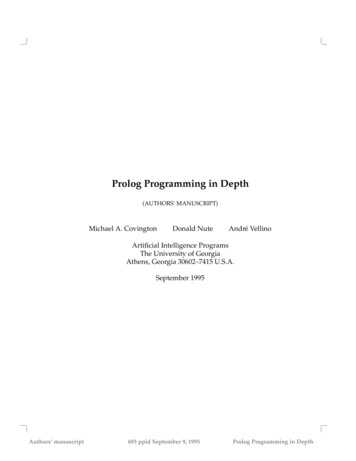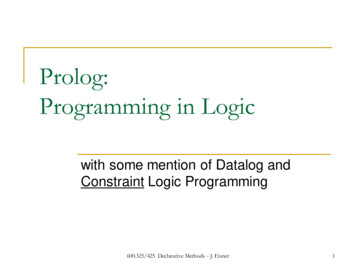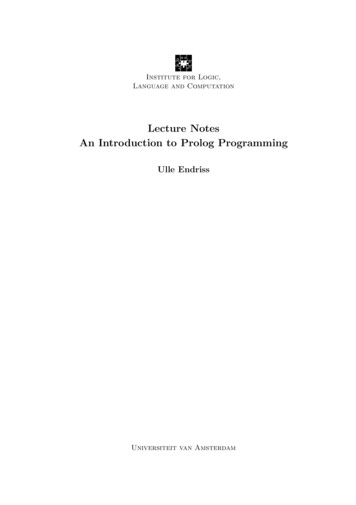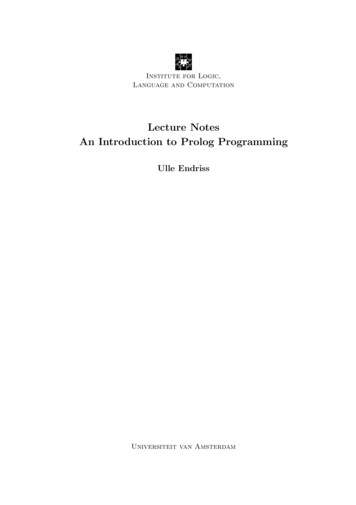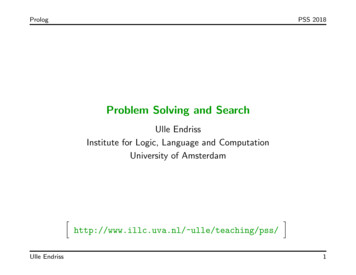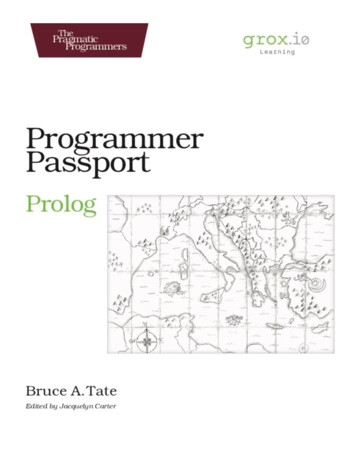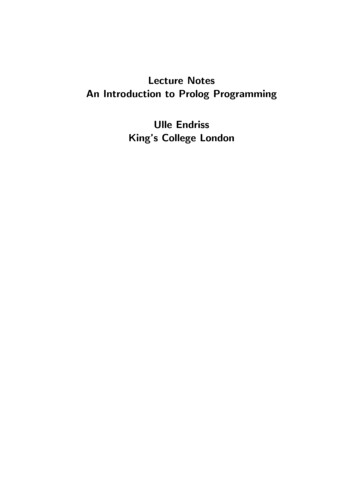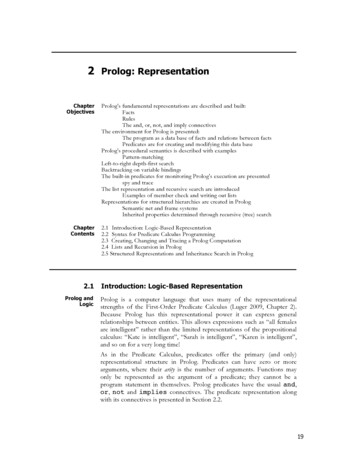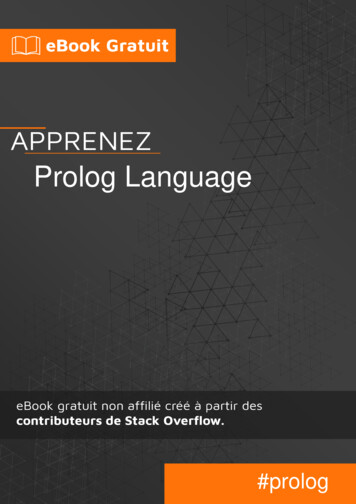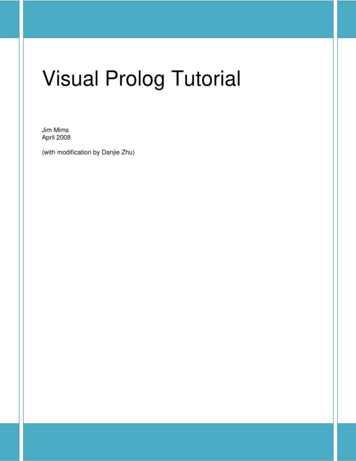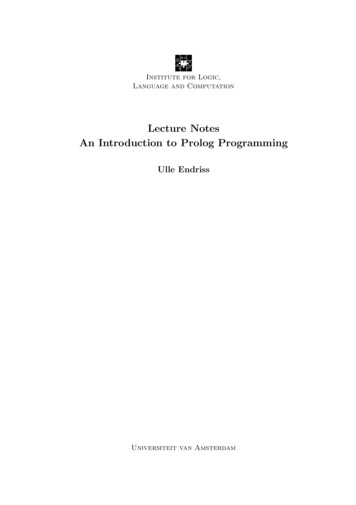
Transcription
Institute for Logic,Language and ComputationLecture NotesAn Introduction to Prolog ProgrammingUlle EndrissUniversiteit van Amsterdam
c by Ulle Endriss, University of Amsterdam (Email: ulle.endriss@uva.nl)Version: 1 September 2014
PrefaceThese lecture notes introduce the declarative programming language Prolog. The emphasis is on learning how to program, rather than on the theory of logic programming.Nevertheless, a short chapter on the logic foundations of Prolog is included as well.All examples have been tested using SWI-Prolog (www.swi-prolog.org) and can be expected to work equally well with most other Prolog systems. These notes have originallybeen developed for a course I taught at King’s College London in 1999 and 2000.Amsterdam, August 2005U.E.The present version corrects a number of minor errors in the text, most of whichhave been pointed out to me by students following a number of courses I have given atthe University of Amsterdam since 2005.Amsterdam, September 2014U.E.iii
Contents1 The Basics1.1 Getting Started: An Example . . . . .1.2 Prolog Syntax . . . . . . . . . . . . . .1.2.1 Terms . . . . . . . . . . . . . .1.2.2 Clauses, Programs and Queries1.2.3 Some Built-in Predicates . . .1.3 Answering Queries . . . . . . . . . . .1.3.1 Matching . . . . . . . . . . . .1.3.2 Goal Execution . . . . . . . . .1.4 A Matter of Style . . . . . . . . . . . .1.5 Exercises . . . . . . . . . . . . . . . .2 List2.12.22.32.4ManipulationNotation . . . . . . . . .Head and Tail . . . . . .Some Built-in PredicatesExercises . . . . . . . . . .for. .11445688101112. . . . . . . . . . . . . . . . . . . . .List Manipulation. . . . . . . . . . .1515151819.3 Arithmetic Expressions213.1 The is-Operator for Arithmetic Evaluation . . . . . . . . . . . . . . . . . 213.2 Predefined Arithmetic Functions and Relations . . . . . . . . . . . . . . . 223.3 Exercises . . . . . . . . . . . . . . . . . . . . . . . . . . . . . . . . . . . . 234 Operators274.1 Precedence and Associativity . . . . . . . . . . . . . . . . . . . . . . . . . 274.2 Declaring Operators with op/3 . . . . . . . . . . . . . . . . . . . . . . . . 304.3 Exercises . . . . . . . . . . . . . . . . . . . . . . . . . . . . . . . . . . . . 315 Backtracking, Cuts and Negation5.1 Backtracking and Cuts . . . . . . . .5.1.1 Backtracking Revisited . . . .5.1.2 Problems with Backtracking .5.1.3 Introducing Cuts . . . . . . .v.3535353637
viContents5.25.35.45.55.1.4 Problems with Cuts . . . . . .Negation as Failure . . . . . . . . . . .5.2.1 The Closed World Assumption5.2.2 The \ -Operator . . . . . . . .Disjunction . . . . . . . . . . . . . . .Example: Evaluating Logic Formulas .Exercises . . . . . . . . . . . . . . . .404141424344466 Logic Foundations of Prolog496.1 Translation of Prolog Clauses into Formulas . . . . . . . . . . . . . . . . . 496.2 Horn Formulas and Resolution . . . . . . . . . . . . . . . . . . . . . . . . 516.3 Exercises . . . . . . . . . . . . . . . . . . . . . . . . . . . . . . . . . . . . 53A Recursive ProgrammingA.1 Complete Induction . .A.2 The Recursion PrincipleA.3 What Problems to SolveA.4 Debugging . . . . . . . .Index.555556575759
Chapter 1The BasicsProlog (programming in logic) is one of the most widely used programming languages inartificial intelligence research. As opposed to imperative languages such as C or Java (thelatter of which also happens to be object-oriented) it is a declarative programming language. That means, when implementing the solution to a problem, instead of specifyinghow to achieve a certain goal in a certain situation, we specify what the situation (rulesand facts) and the goal (query) are and let the Prolog interpreter derive the solution forus. Prolog is very useful in some problem areas, such as artificial intelligence, naturallanguage processing, databases, . . . , but pretty useless in others, such as graphics ornumerical algorithms.By following this course, you will learn how to use Prolog as a programming languageto solve practical problems in computer science and artificial intelligence. You will alsolearn how the Prolog interpreter actually works. The latter will include an introductionto the logical foundations of the Prolog language.These notes cover the most important Prolog concepts you need to know about, butit is certainly worthwhile to also have a look at the literature. The following three arewell-known titles, but you may also consult any other textbook on Prolog. I. Bratko. Prolog Programming for Artificial Intelligence. 4th edition, AddisonWesley Publishers, 2012. F. W. Clocksin and C. S. Mellish. Programming in Prolog. 5th edition, SpringerVerlag, 2003. L. Sterling and E. Shapiro. The Art of Prolog. 2nd edition, MIT Press, 1994.1.1Getting Started: An ExampleIn the introduction it has been said that Prolog is a declarative (or descriptive) language.Programming in Prolog means describing the world. Using such programs means askingProlog questions about the previously described world. The simplest way of describingthe world is by stating facts, like this one:1
2Chapter 1. The Basicsbigger(elephant, horse).This states, quite intuitively, the fact that an elephant is bigger than a horse. (Whetherthe world described by a Prolog program has anything to do with our real world is, ofcourse, entirely up to the programmer.) Let’s add a few more facts to our little program:bigger(elephant, horse).bigger(horse, donkey).bigger(donkey, dog).bigger(donkey, monkey).This is a syntactically correct program, and after having compiled it we can ask the Prologsystem questions (or queries in proper Prolog-jargon) about it. Here’s an example:?- bigger(donkey, dog).YesThe query bigger(donkey, dog) (i.e., the question “Is a donkey bigger than a dog?”)succeeds, because the fact bigger(donkey, dog) has previously been communicated tothe Prolog system. Now, is a monkey bigger than an elephant?- bigger(monkey, elephant).NoNo, it’s not. We get exactly the answer we expected: the corresponding query, namelybigger(monkey, elephant) fails. But what happens when we ask the other way round?- bigger(elephant, monkey).NoAccording to this elephants are not bigger than monkeys. This is clearly wrong as far asour real world is concerned, but if you check our little program again, you will find thatit says nothing about the relationship between elephants and monkeys. Still, we knowthat if elephants are bigger than horses, which in turn are bigger than donkeys, which inturn are bigger than monkeys, then elephants also have to be bigger than monkeys. Inmathematical terms: the bigger-relation is transitive. But this has also not been definedin our program. The correct interpretation of the negative answer Prolog has given is thefollowing: from the information communicated to the system it cannot be proved thatan elephant is bigger than a monkey.If, however, we would like to get a positive reply for a query like bigger(elephant,monkey), we have to provide a more accurate description of the world. One way of doingthis would be to add the remaining facts, such as bigger(elephant, monkey), to ourprogram. For our little example this would mean adding another 5 facts. Clearly toomuch work and probably not too clever anyway.The far better solution would be to define a new relation, which we will callis bigger, as the transitive closure (don’t worry if you don’t know what that means)
Ulle Endriss. And Introduction to Prolog Programming3of bigger. Animal X is bigger than animal Y either if this has been stated as a fact or ifthere is an animal Z for which it has been stated as a fact that animal X is bigger thananimal Z and it can be shown that animal Z is bigger than animal Y. In Prolog suchstatements are called rules and are implemented like this:is bigger(X, Y) :- bigger(X, Y).is bigger(X, Y) :- bigger(X, Z), is bigger(Z, Y).In these rules :- means something like “if” and the comma between the two termsbigger(X, Z) and is bigger(Z, Y) stands for “and”. X, Y, and Z are variables, whichin Prolog is indicated by using capital letters.You can think of the the bigger-facts as data someone has collected by browsingthrough the local zoo and comparing pairs of animals. The implementation of is bigger,on the other hand, could have been provided by a knowledge engineer who may notknow anything at all about animals, but understands the general concept of somethingbeing bigger than something else and thereby has the ability to formulate general rulesregarding this relation. If from now on we use is bigger instead of bigger in ourqueries, the program will work as intended:?- is bigger(elephant, monkey).YesProlog still cannot find the fact bigger(elephant, monkey) in its database, so it triesto use the second rule instead. This is done by matching the query with the head of therule, which is is bigger(X, Y). When doing so the two variables get instantiated: X elephant and Y monkey. The rule says that in order to prove the goal is bigger(X,Y) (with the variable instantiations that’s equivalent to is bigger(elephant, monkey))Prolog has to prove the two subgoals bigger(X, Z) and is bigger(Z, Y), again withthe same variable instantiations. This process is repeated recursively until the factsthat make up the chain between elephant and monkey are found and the query finallysucceeds. How this goal execution as well as term matching and variable instantiationreally work will be examined in more detail in Section 1.3.Of course, we can do slightly more exiting stuff than just asking yes/no-questions.Suppose we want to know, what animals are bigger than a donkey? The correspondingquery would be:?- is bigger(X, donkey).Again, X is a variable. We could also have chosen any other name for it, as long as itstarts with a capital letter. The Prolog interpreter replies as follows:?- is bigger(X, donkey).X horseHorses are bigger than donkeys. The query has succeeded, but in order to allow it tosucceed Prolog had to instantiate the variable X with the value horse. If this makes us
4Chapter 1. The Basicshappy already, we can press Return now and that’s it. In case we want to find out ifthere are more animals that are bigger than the donkey, we can press the semicolon key,which will cause Prolog to search for alternative solutions to our query. If we do thisonce, we get the next solution X elephant: elephants are also bigger than donkeys.Pressing semicolon again will return a No, because there are no more solutions:?- is bigger(X, donkey).X horse ;X elephant ;NoThere are many more ways of querying the Prolog system about the contents of itsdatabase. As a final example we ask whether there is an animal X that is both smallerthan a donkey and bigger than a monkey:?- is bigger(donkey, X), is bigger(X, monkey).NoThe (correct) answer is No. Even though the two single queries is bigger(donkey, X)and is bigger(X, monkey) would both succeed when submitted on their own, theirconjunction (represented by the comma) does not.This section has been intended to give you a first impression of Prolog programming.The next section provides a more systematic overview of the basic syntax.There are a number of Prolog systems around that you can use. How to start aProlog session may differ slightly from one system to the next, but it should not be toodifficult to find out by consulting the user manual of your system. The examples in thesenotes have all been generated using SWI-Prolog (in its 1999 incarnation, with only a fewminor adjustments made later on).11.2Prolog SyntaxThis section describes the most basic features of the Prolog programming language.1.2.1TermsThe central data structure in Prolog is that of a term. There are terms of four kinds:atoms, numbers, variables, and compound terms. Atoms and numbers are sometimesgrouped together and called atomic terms.1One difference between “classical” Prolog and more recent versions of SWI-Prolog is that the latterreports true rather than Yes when a query succeeds and false rather than No when a query fails. Therealso a a few other very minor differences in how modern SWI-Prolog responds to queries. If you areinterested in the finer subtleties of this matter, search the Internet for “Prolog toplevel”.
Ulle Endriss. And Introduction to Prolog Programming5Atoms. Atoms are usually strings made up of lower- and uppercase letters, digits, andthe underscore, starting with a lowercase letter. The following are all valid Prolog atoms:elephant, b, abcXYZ, x 123, another pint for me pleaseOn top of that also any series of arbitrary characters enclosed in single quotes denotesan atom.’This is also a Prolog atom.’Finally, strings made up solely of special characters like - * : & (check themanual of your Prolog system for the exact set of these characters) are also atoms.Examples: , ::, ------ , ***Numbers. All Prolog implementations have an integer type: a sequence of digits,optionally preceded by a - (minus). Some also support floats. Check the manual fordetails.Variables. Variables are strings of letters, digits, and the underscore, starting with acapital letter or an underscore. Examples:X, Elephant, 4711, X 1 2, MyVariable,The last one of the above examples (the single underscore) constitutes a special case.It is called the anonymous variable and is used when the value of a variable is of noparticular interest. Multiple occurrences of the anonymous variable in one expressionare assumed to be distinct, i.e., their values don’t necessarily have to be the same. Moreon this later.Compound terms. Compound terms are made up of a functor (a Prolog atom) anda number of arguments (Prolog terms, i.e., atoms, numbers, variables, or other compound terms) enclosed in parentheses and separated by commas. The following are someexamples for compound terms:is bigger(horse, X), f(g(X, ), 7), ’My Functor’(dog)It’s important not to put any blank characters between the functor and the openingparentheses, or Prolog won’t understand what you’re trying to say. In other places,however, spaces can be very helpful for making programs more readable.The sets of compound terms and atoms together form the set of Prolog predicates.A term that doesn’t contain any variables is called a ground term.1.2.2Clauses, Programs and QueriesIn the introductory example we have already seen how Prolog programs are made up offacts and rules. Facts and rules are also called clauses.
6Chapter 1. The BasicsFacts.A fact is a predicate followed by a full stop. Examples:bigger(whale, ).life is beautiful.The intuitive meaning of a fact is that we define a certain instance of a relation as beingtrue.Rules. A rule consists of a head (a predicate) and a body. (a sequence of predicatesseparated by commas). Head and body are separated by the sign :- and, like everyProlog expression, a rule has to be terminated by a full stop. Examples:is smaller(X, Y) :- is bigger(Y, X).aunt(Aunt, Child) :sister(Aunt, Parent),parent(Parent, Child).The intuitive meaning of a rule is that the goal expressed by its head is true, if we (orrather the Prolog system) can show that all of the expressions (subgoals) in the rule’sbody are true.Programs.A Prolog program is a sequence of clauses.Queries. After compilation a Prolog program is run by submitting queries to the interpreter. A query has the same structure as the body of a rule, i.e., it is a sequence ofpredicates separated by commas and terminated by a full stop. They can be entered atthe Prolog prompt, which in most implementations looks something like this: ?-. Whenwriting about queries we often include the ?-. Examples:?- is bigger(elephant, donkey).?- small(X), green(X), slimy(X).Intuitively, when submitting a query like the last example, we ask Prolog whether all itspredicates are provably true, or in other words whether there is an X such that small(X),green(X), and slimy(X) are all true.1.2.3Some Built-in PredicatesWhat we have seen so far is already enough to write simple programs by defining predicates in terms of facts and rules, but Prolog also provides a range of useful built-inpredicates. Some of them will be introduced in this section; all of them should be explained in the user manual of your Prolog system.Built-ins can be used in a similar way as user-defined predicates. The importantdifference between the two is that a built-in predicate is not allowed to appear as theprincipal functor in a fact or the head of a rule. This must be so, because using them insuch a position would effectively mean changing their definition.
Ulle Endriss. And Introduction to Prolog Programming7Equality. Maybe the most important built-in predicate is (equality). Instead ofwriting expressions such as (X, Y), we usually write more conveniently X Y. Such agoal succeeds, if the terms X and Y can be matched. This will be made more precise inSection 1.3.Guaranteed success and certain failure. Sometimes it can be useful to have predicates that are known to either fail or succeed in any case. The predicates fail and trueserve exactly this purpose. Some Prolog systems also provide the predicate false, withexactly the same functionality as fail.Consulting program files. Program files can be compiled using the predicateconsult/1.2 The argument has to be a Prolog atom denoting the program file youwant to compile. For example, to compile the file big-animals.pl submit the followingquery to Prolog:?- consult(’big-animals.pl’).If the compilation is successful, Prolog will reply with Yes. Otherwise a list of errors willbe displayed.Output. If besides Prolog’s replies to queries you wish your program to have furtheroutput you can use the write/1 predicate. The argument can be any valid Prolog term.In the case of a variable its value will get printed to the screen. Execution of the predicatenl/0 causes the system to skip a line. Here are two examples:?- write(’Hello World!’), nl.Hello World!Yes?- X elephant, write(X), nl.elephantX elephantYesIn the second example, first the variable X is bound to the atom elephant and then thevalue of X, i.e., elephant, is written on the screen using the write/1 predicate. Afterskipping to a new line, Prolog reports the variable binding(s), i.e., X elephant.Checking the type of a Prolog term. There are a number of built-in predicatesavailable that can be used to check the type of a given Prolog term. Here are someexamples:2The /1 is used to indicate that this predicate takes one argument.
8Chapter 1. The Basics?- atom(elephant).Yes?- atom(Elephant).No?- X f(mouse), compound(X).X f(mouse)YesThe last query succeeds, because the variable X is bound to the compound term f(mouse)at the time the subgoal compound(X) is being executed.Help. Most Prolog systems also provide a help function in the shape of a predicate,usually called help/1. Applied to a term (like the name of a built-in predicate) thesystem will display a short description, if available. Example:?- help(atom).atom( Term)Succeeds if Term is bound to an atom.1.3Answering QueriesWe have mentioned the issue of term matching before in these notes. This concept iscrucial to the way Prolog replies to queries, so we present it before describing whatactually happens when a query is processed (or more generally speaking: when a goal isexecuted).1.3.1MatchingTwo terms are said to match if they are either identical or if they can be made identicalby means of variable instantiation. Instantiating a variable means assigning it a fixedvalue. Two free variables also match, because they could be instantiated with the sameground term.It is important to note that the same variable has to be instantiated with the samevalue throughout an expression. The only exception to this rule is the anonymous variable , which is considered to be unique whenever it occurs.We give some examples. The terms is bigger(X, dog) and is bigger(elephant,dog) match, because the variable X can be instantiated with the atom elephant. Wecould test this in the Prolog interpreter by submitting the corresponding query to whichProlog would react by listing the appropriate variable instantiations:?- is bigger(X, dog) is bigger(elephant, dog).
Ulle Endriss. And Introduction to Prolog Programming9X elephantYesThe following is an example for a query that doesn’t succeed, because X cannot matchwith 1 and 2 at the same time.?- p(X, 2, 2) p(1, Y, X).NoIf, however, instead of X we use the anonymous variable , matching is possible, becauseevery occurrence of represents a distinct variable. During matching Y is instantiatedwith 2:?- p( , 2, 2) p(1, Y, ).Y 2YesAnother example for matching:?- f(a, g(X, Y)) f(X, Z), Z g(W, h(X)).X aY h(a)Z g(a, h(a))W aYesSo far so good. But what happens, if matching is possible even though no specific variableinstantiation has to be enforced (like in all previous examples)? Consider the followingquery:?- X my functor(Y).X my functor( G177)Y G177YesIn this example matching succeeds, because X could be a compound term with the functormy functor and a non-specified single argument. Y could be any valid Prolog term, butit has to be the same term as the argument inside X. In Prolog’s output this is denotedthrough the use of the variable G177. This variable has been generated by Prolog duringexecution time. Its particular name, G177 in this case, may be different every time thequery is submitted.In fact, what the output for the above example will look like exactly will depend on theProlog system you use. For instance, some systems will avoid introducing a new variable(here G177) and instead simply report the variable binding as X my functor(Y).
10Chapter 1. The Basics1.3.2Goal ExecutionSubmitting a query means asking Prolog to try to prove that the statement(s) impliedby the query can be made true provided the right variable instantiations are made. Thesearch for such a proof is usually referred to as goal execution. Each predicate in the queryconstitutes a (sub)goal, which Prolog tries to satisfy one after the other. If variables areshared between several subgoals their instantiations have to be the same throughout theentire expression.If a goal matches with the head of a rule, the respective variable instantiations aremade inside the rule’s body, which then becomes the new goal to be satisfied. If the bodyconsists of several predicates the goal is again split into subgoals to be executed in turn.In other words, the head of a rule is considered provably true, if the conjunction of allits body-predicates are provably true. If a goal matches with a fact in our program, theproof for that goal is complete and the variable instantiations made during matching arecommunicated back to the surface. Note that the order in which facts and rules appearin our program is important here. Prolog will always try to match its current goal withthe first possible fact or rule-head it can find.If the principal functor of a goal is a built-in predicate the associated action is executed whilst the goal is being satisfied. For example, as far as goal execution is concernedthe predicatewrite(’Hello World!’)will simply succeed, but at the same time it will also print the words Hello World! onthe screen.As mentioned before, the built-in predicate true will always succeed (without anyfurther side-effects), whereas fail will always fail.Sometimes there is more than one way of satisfying the current goal. Prolog choosesthe first possibility (as determined by the order of clauses in a program), but the factthat there are alternatives is recorded. If at some point Prolog fails to prove a certainsubgoal, the system can go back and try an alternative way of executing the previousgoal. This process is known as backtracking.We shall exemplify the process of goal execution by means of the following famousargument:All men are mortal.Socrates is a man.Hence, Socrates is mortal.In Prolog terms, the first statement represents a rule: X is mortal, if X is a man (for allX). The second one constitutes a fact: Socrates is a man. This can be implemented inProlog as follows:mortal(X) :- man(X).man(socrates).
Ulle Endriss. And Introduction to Prolog Programming11Note that X is a variable, whereas socrates is an atom. The conclusion of the argument,“Socrates is mortal”, can be expressed through the predicate mortal(socrates). Afterhaving consulted the above program we can submit this predicate to Prolog as a query,which will cause the following reaction:?- mortal(socrates).YesProlog agrees with our own logical reasoning. Which is nice. But how did it come to itsconclusion? Let’s follow the goal execution step by step.(1) The query mortal(socrates) is made the initial goal.(2) Scanning through the clauses of our program, Prolog tries to matchmortal(socrates) with the first possible fact or head of rule. It finds mortal(X),the head of the first (and only) rule. When matching the two terms the instantiation X socrates needs to be made.(3) The variable instantiation is extended to the body of the rule, i.e., man(X) becomesman(socrates).(4) The newly instantiated body becomes our new goal: man(socrates).(5) Prolog executes the new goal by again trying to match it with a rule-head or a fact.Obviously, the goal man(socrates) matches the fact man(socrates), because theyare identical. This means the current goal succeeds.(6) This, again, means that also the initial goal succeeds.1.4A Matter of StyleOne of the major advantages of Prolog is that it allows for writing very short and compactprograms solving not only comparatively difficult problems, but also being readable and(again: comparatively) easy to understand.Of course, this can only work, if the programmer (you!) pays some attention to hisor her programming style. As with every programming language, comments do help. InProlog comments are enclosed between the two signs /* and */, like this:/* This is a comment.*/Comments that only run over a single line can also be started with the percentage sign%. This is usually used within a clause.aunt(X, Z) :sister(X, Y),parent(Y, Z).% A comment on this subgoal.
12Chapter 1. The BasicsBesides the use of comments a good layout can improve the readability of your programssignificantly. The following are some basic rules most people seem to agree on:(1) Separate clauses by one or more blank lines.(2) Write only one predicate per line and use indentation:blond(X) :father(Father, X),blond(Father),mother(Mother, X),blond(Mother).(Very short clauses may also be written in a single line.)(3) Insert a space after every comma inside a compound term:born(mary, yorkshire, ’01/01/1995’)(4) Write short clauses with bodies consisting of only a few goals. If necessary, splitinto shorter sub-clauses.(5) Choose meaningful names for your variables and atoms.1.5ExercisesExercise 1.1. Try to answer the following questions first “by hand” and then verifyyour answers using a Prolog interpreter.(a) Which of the following are valid Prolog atoms?f, loves(john,mary), Mary, c1, ’Hello’, this is it(b) Which of the following are valid names for Prolog variables?a, A, Paul, ’Hello’, a 123, , abc, x2(c) What would a Prolog interpreter reply given the following query?- f(a, b) f(X, Y).(d) Would the following query succeed?- loves(mary, john) loves(John, Mary).Why?(e) Assume a program consisting only of the facta(B, B).has been consulted by Prolog. How will the system react to the following query?- a(1, X), a(X, Y), a(Y, Z), a(Z, 100).Why?
Ulle Endriss. And Introduction to Prolog Programming13Exercise 1.2. Read the section on matching again and try to understand what’s happening when you submit the following queries to Prolog.(a) ?- myFunctor(1, 2) X, X myFunctor(Y, Y).(b) ?- f(a, , c, d) f(a, X, Y, ).(c) ?- write(’One ’), X write(’Two ’).Exercise 1.3. Draw the family tree corresponding to the following Prolog le(bob).male(harry).parent(bob, lisa).parent(bob, paul).parent(bob, mary).parent(juliet, lisa).parent(juliet, paul).parent(juliet, mary).parent(peter, harry).parent(lisa, harry).parent(mary, dick).parent(mary, sandra).After having copied the given program, define new predicates (in terms of rules usingmale/1, female/1 and parent/2) for the following family relations:(a) father(b) sister(c) grandmother(d) cousinYou may want to use the operator \ , which is the opposite of . A goal like X \ Ysucceeds, if the two terms X and Y cannot be matched.Example: X is the brother of Y, if they have a parent Z in common and if X is male andif X and Y don’t represent the same person. In Prolog this can be expressed through thefollowing rule:
14Chapter 1. The Basicsbrother(X, Y) :parent(Z, X),parent(Z, Y),male(X),X \ Y.Exercise 1.4. Most people will probably find all of this rather daunting at first. Readthe chapter again in a few weeks’ time when you will have gained some programmingexperience in Prolog and enjoy the feeling of enlightenment. The part on the syntaxof the Prolog language and the stuff on matching and goal execution are particularlyimportant.
Chapter 2List ManipulationThis chapter introduces a special notation for lists, one of the most important datastructures in Prolog, and provides some examples for how to work with them.2.1NotationLists are contained in square brackets with the e
By following this course, you will learn how to use Prolog as a programming language to solve practical problems in computer science and arti cial intelligence. You will also . The simplest way of describing the world is by stating facts, like this one: 1. 2 Chapter 1. The Basics
